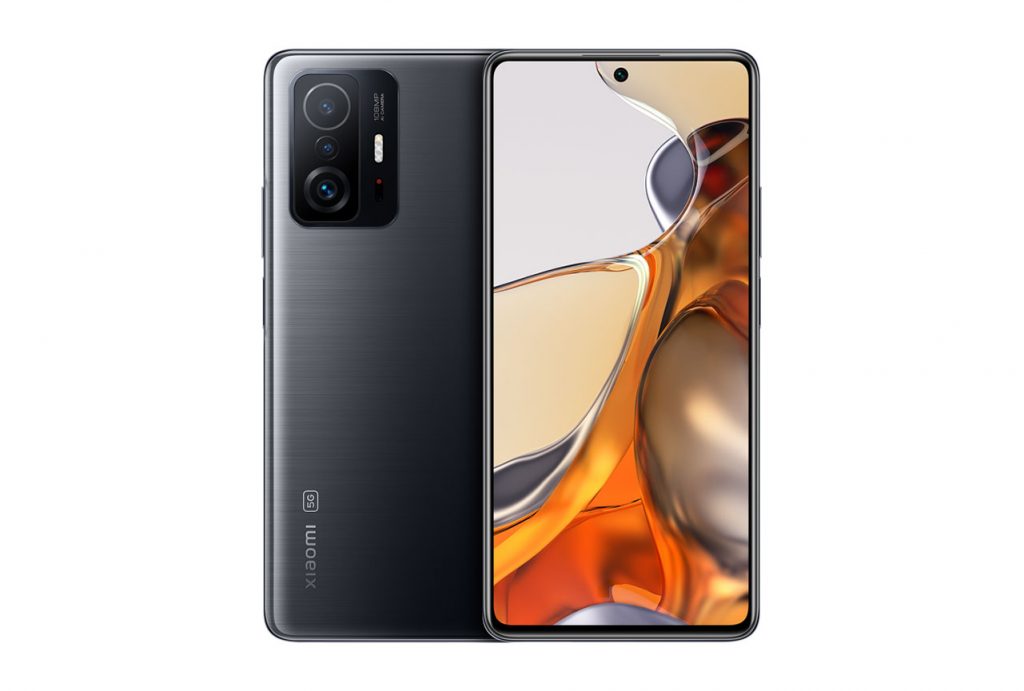The Xiaomi 11T Pro arrived on the market in October 2021 and comes with a 108 MP main camera and Dolby Vision, among other premium features. Let’s see how it did in our comprehensive suite of display tests.
Key display specifications:
- 6.67-inch OLED display
- 164.1 x 76.9 x 8.8 mm (6.46 x 3.03 x 0.35 inches)
- Resolution: 1080 x 2400 (395 ppi)
- Aspect ratio: 20:9
- Refresh rate: 120 Hz
- Qualcomm Snapdragon 888 5G (5 nm) chipset
About DXOMARK Display tests: For scoring and analysis in our smartphone and other display reviews, DXOMARK engineers perform a variety of objective and perceptual tests under controlled lab and real-life conditions. This article highlights the most important results of our testing. Note that we evaluate display attributes using only the device’s built-in display hardware and its still image (gallery) and video apps at their default settings. (For in-depth information about how we evaluate smartphone and other displays, check out our articles, “How DXOMARK tests display quality” and “A closer look at DXOMARK Display testing.”)
Test summary
Scoring
Sub-scores and attributes included in the calculations of the global score.
 Xiaomi 11T Pro
Xiaomi 11T Pro

125
display
122
Apple iPhone 14 Pro Max
Best: Apple iPhone 14 Pro Max (160)
143
Sony Xperia 5 IV
Best: Sony Xperia 5 IV (163)
135
Samsung Galaxy S22 Ultra (Snapdragon)
Best: Samsung Galaxy S22 Ultra (Snapdragon) (162)
124
Huawei P40 Pro
Best: Huawei P40 Pro (155)
102
OnePlus 9
Best: OnePlus 9 (165)
116
LG Wing
Best: LG Wing (149)
Please be aware that beyond this point, we have not modified the initial test results. While data and products remain fully comparable, you might encounter mentions and references to the previous scores.
Position in Global Ranking

48
th
1. Apple iPhone 14 Pro Max
149
4. Apple iPhone 13 Pro Max
145
12. Samsung Galaxy S22 Ultra (Snapdragon)
136
14. Samsung Galaxy S22+ (Exynos)
135
16. Samsung Galaxy Z Flip4
134
16. Samsung Galaxy S22 Ultra (Exynos)
134
16. Vivo X80 Pro (Mediatek)
134
19. Samsung Galaxy Z Fold4
133
19. Samsung Galaxy S22 (Snapdragon)
133
19. Samsung Galaxy S22 (Exynos)
133
19. Vivo X80 Pro (Snapdragon)
133
24. Samsung Galaxy S21 Ultra 5G (Snapdragon)
131
24. Samsung Galaxy S21 Ultra 5G (Exynos)
131
28. Samsung Galaxy S21 FE 5G (Snapdragon)
130
33. Samsung Galaxy Z Fold3 5G
129
33. Samsung Galaxy Note20 Ultra 5G (Snapdragon)
129
39. Samsung Galaxy Z Flip3 5G
128
39. Samsung Galaxy Note20 Ultra 5G (Exynos)
128
42. Apple iPhone 12 Pro Max
127
48. Vivo X70 Pro (MediaTek)
125
48. Vivo X60 Pro 5G (Snapdragon)
125
63. Oppo Reno6 Pro 5G (Snapdragon)
123
63. Samsung Galaxy S20 Ultra 5G (Exynos)
123
67. Apple iPhone SE (2022)
122
80. Apple iPhone 11 Pro Max
116
85. Samsung Galaxy A52 5G
111
89. Samsung Galaxy A52s 5G
110
94. Xiaomi Redmi K50 Gaming
107
97. Samsung Galaxy A53 5G
104
103. Microsoft Surface Duo
99
105. Nubia RedMagic 7 Pro
97
106. Xiaomi Mi 10T Pro 5G
95
114. Samsung Galaxy A22 5G
74
115. Xiaomi Black Shark 3 Pro
69
117. Lenovo Legion Phone 2 Pro
60
Position in Premium Ranking

9
th
3. Samsung Galaxy S22 (Snapdragon)
133
3. Samsung Galaxy S22 (Exynos)
133
5. Samsung Galaxy S21 FE 5G (Snapdragon)
130
9. Vivo X70 Pro (MediaTek)
125
9. Vivo X60 Pro 5G (Snapdragon)
125
15. Oppo Reno6 Pro 5G (Snapdragon)
123
36. Lenovo Legion Phone 2 Pro
60
Pros
- Faithful colors in most lighting conditions
- Good brightness management in low light and low flicker
- Smooth touch interactions and absence of frame drops when gaming
Cons
- Altered image rendering and lack of details under direct sunlight
- Low details in dark tones and a green cast on some HDR10 content
- Occasional ghost touches, especially in corners
The Xiaomi 11T Pro showed many strengths in DXOMARK Display testing, providing good readability and reducing eye strain thanks to good brightness management and a high flicker frequency (the higher the frequency, the less noticeable the flicker). Colors are very accurate in most viewing conditions, and motion is smooth when gaming. On the downside, image rendering looks unnatural and detail is lost in bright sunlight, so images and videos are best viewed indoors or any other less extreme conditions.
Brightness vs Contrast comparison (0 Lux)
Brightness vs Contrast comparison (30 000 Lux)
The Xiaomi 11T Pro is comfortable for reading in a low-light environment and when the blue light filter is on. But it lacks detail and brightness in indoor conditions. Outdoors, the brightness has been measured over an impressive 1000 nits, but an awkward picture rendering deteriorates the experience under sunlight, as shown in the sample illustration below.
Readability under sunlight, from left to right: Xiaomi 11T Pro, Xiaomi Mi 11, Samsung Galaxy A52 5G, Oppo Reno5 Pro 5G
(Photo credit: DXOMARK; for illustration only)
Our engineers wanted to illustrate the unnatural rendering more clearly. For that, they compared the behavior of the Xiaomi 11T Pro and the Xiaomi Mi 11 when illuminated by a strong light source. They placed the device in indoor conditions and pointed a spotlight at the devices’ ambient light sensors, with very interesting results. You can see strong artifacts in the image viewed on the Xiaomi 11T Pro, with the eyebrows and other low-contrast areas completely blurred, and the eye color unnatural.
Indoors, high brightness: Xiaomi 11T Pro on the left, Xiaomi Mi 11 on the right. The tone mapping on the Xiaomi 11T Pro leads to unnatural rendering.
(Photo credit: DXOMARK; for illustration only)
Xiaomi 11T Pro, crop: Details are lost in the iris and in the eyebrows; eye color is unnatural.
(Photo credit: DXOMARK; for illustration only)
Xiaomi Mi 11, crop: Image shows better detail and color.
(Photo credit: DXOMARK; for illustration only)
Under less challenging light conditions, here 1000 lux D65 illuminant, the Xiaomi 11T Pro has a very good color reproduction with an average 1.9 JNCD in the P3 color space, making color fidelity one of the device’s strong points. The center of each circle is the target color; the further the tip of the arrow is outside of the circle, the more users will notice the difference between the color on the display and the original color of the source material. As you can see all tested colors stays inside the acceptable range.
The scatter chart on the right shows the Xiaomi device’s strong shift toward green when holding it at different angles.
Xiaomi 11T Pro, color fidelity at 1000 lux in the P3 color space
Xiaomi 11T Pro, scatter graph of white point on angle
The second photo array below illustrates the findings shown in the right-hand chart above — that is, images on the Xiaomi 11T Pro take on a green cast when viewed at an angle; further, there is a loss of color saturation on angle as well.
Brightness and color on axis (top) and on angle (bottom), from left to right: Xiaomi 11T Pro, Xiaomi Mi 11, Samsung Galaxy A52 5G, Oppo Reno5 Pro 5G
(Photo credit: DXOMARK; for illustration only)
The Xiaomi 11T Pro’s video brightness is well adapted for watching HDR10 content, in comparison the other devices are all a bit dim which can be disturbing in such low light environment. On the other hand, the Xiaomi 11T Pro contrast is somewhat low on mid-tones and details are missing in dark content. The device also has a bit of a green cast that is noticeable on skin tones.
Video color, clockwise from top left: Xiaomi 11T Pro, Xiaomi Mi 11, Samsung Galaxy A52 5G, Oppo Reno5 Pro 5G
(Photo credit: DXOMARK; for illustration only)
The Xiaomi 11T Pro device shows many frame drops at 30 fps, as shown below, but surprisingly only a few stutters at 60 fps; however, no frame drops are visible when playing games. When played back, the 11T Pro pauses before resuming on some of the tested videos.
Xiaomi 11T Pro, frame drops at 30 fps
Xiaomi 11T Pro, frame drops at 60 fps
While gaming, corners are touch-responsive and the device is fairly accurate. The device could be smoother when browsing, however, and a few frame duplications are visible when swiping in the gallery app.
The Xiaomi 11T Pro is the best device in our database in terms of screen reflectance, reaching a 4.2%. It is particularly useful when under intense ambient lighting.
The Xiaomi 11T Pro flickers at 486 Hz, which is a high frequency for OLED displays. Moreover, the device has a flicker-free feature that works very well.
Flicker comparison
This graph represents the frequencies of lighting variation; the highest peak gives the main flicker frequency.
Although the 11T Pro is too responsive to ghost touches, especially in the corners, this does not detract from the gaming experience, and the device manages aliasing well as you can see on the crops below.
Xiaomi 11T Pro: Aliasing effects on the Asphalt 9 game.
(Photo credit: DXOMARK; for illustration only)
Edges show very little stairsteps.
Overall, the 11T Pro reached a respectable Display score for its price segment. Its versatility will provide most users a satisfying experience.
 Xiaomi 11T Pro
Xiaomi 11T Pro


 48th
48th
 9th
9th

















 English
English 中文
中文

DXOMARK invites our readership (you) to post comments on the articles on this website. Read more about our Comment Policy.